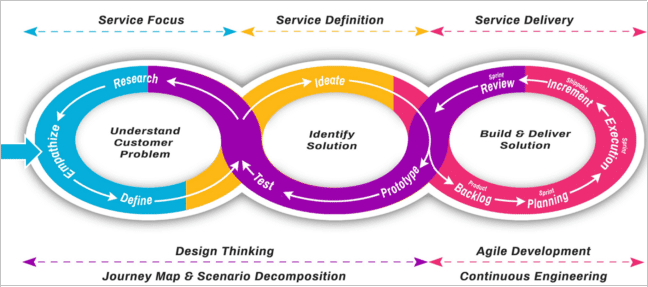Why these 3 stages can guarantee a desired Minimum Viable Product?

A Minimum Viable Product is that version of a new product which allows a team to collect the maximum amount of validated learning about customers with the least effort. — Eric Ries
While many organizations are using digital technologies into their areas of business, looking at customer’s problems and solving those can be processed in 3 stages i.e. Service Focus, Service Definition and Service Delivery. These stages include some of the scientific activities for analyzing how users interact with products and investigating the conditions in which they operate..
With this successful engineered model, building the desired minimum viable product is guaranteed.
Service Focus: Understand Customer problem
- Empathize: It is essential to understand the real problem of the end-users before building a product. Empathize before defining the problem, by talking to the actual end-users and putting one’s self in their shoes to understand the process involved, by not being judgmental. Empathy often is the engine of innovation. Understand the gap of emotional equilibrium between how they are feeling, what they have been doing and what they have been thinking, so the suitable market need is identified.
- Define: Let the outcome of empathizing be the definition of the personas, challenges and their pain points. It is very critical to explicitly define the problem during the phase of defining the service focus.
- Research: Let us not restrict ourselves not to research and not to go back to empathize and re-define the as necessary.
Service Definition: Identify Solution
- Ideate: While Service focus is more divergent in empathizing and convergent in nature in defining the problem, service definition should be
more emergent.
Bring together perspectives and strengths of team members, collectively go wild and be more radical, so your thought process goes beyond the obvious solutions, to think of vibrant design alternatives and to uncover the unexpected idea to solve the problem. - Prototype: Build a minimum viable product based on the core engine of the finalized idea, with just enough features to satisfy the early customers, so they can provide feedback for future product development. Understand there is a huge difference between minimal version product and minimum viable product.
- Test: Get feedback of the prototype as often as possible from the end-users, so you can loop through the empathizing, redefining, ideating and updating the prototype, as required, until the core engine is tuned to solve the problem.
Service Delivery: Build and Deliver the solution
While it was very essential to build the right thing during the service definition phase, service delivery should focus on building the thing right. Agile is best implemented in an emergent organization where the business model is context-driven and it does not matter how it is achieved. This is is where you define the scope of the Minimum Viable Product. Iterate through the required number of sprints to produce shippable deliverables in each sprint.

- Product Backlog: The Product Backlog is a prioritized list of values the team can deliver. It is a set of Epics, Features and User stories which is owned by the Product Owner, subject to addition, change, and reprioritization as needed.
- Sprint Planning: In Sprint Planning, the team chooses the prioritized backlog items they will work on in the upcoming sprint and what they believe they can complete in the sprint, based on the team’s velocity, which then becomes the Spring backlog. Once all members agree the Sprint Backlog is achievable, the Sprint starts
- Sprint Execution: The sprint is executed through daily scrum self-driven by the Scrum master and the team. Each team member briefly reports their progress since yesterday, the plans for today, and anything impeding their progress.
- Shippable increment: The outcome of a Sprint should be of shippable quality, by meeting all the quality criteria set by the team and Product Owner.
- Sprint review and Retrospective: The Sprint team demonstrates the software to show the accomplished value to the stakeholders.
They also do a self-retrospective to reflect on what went well and which areas need improvement and take action items as input to the next Sprint.
By following through these three phases by focusing on what problem you are solving, defining the solution and delivering the solution, you are 100% guaranteed to build the right product and the product right.